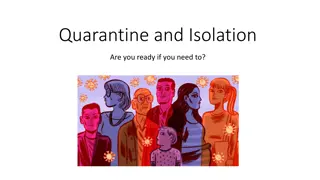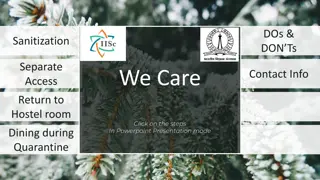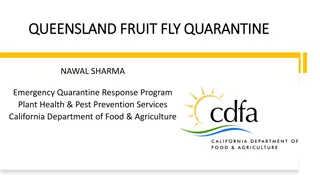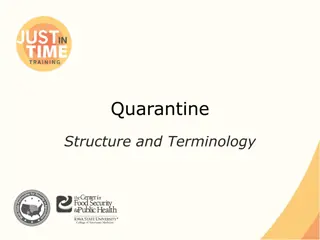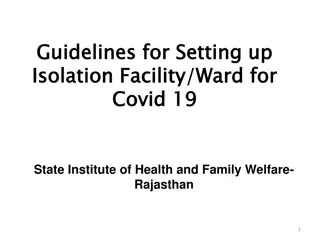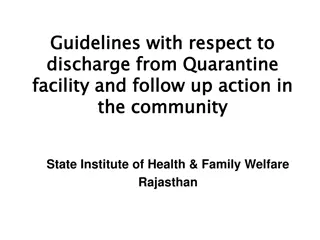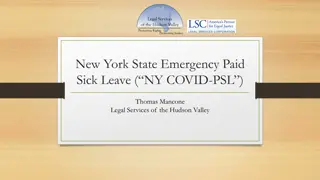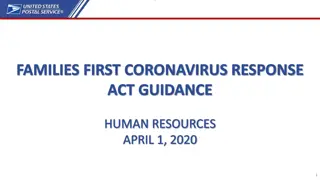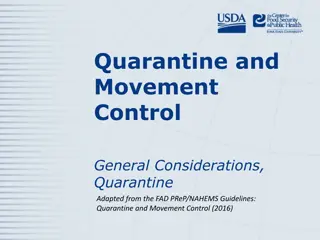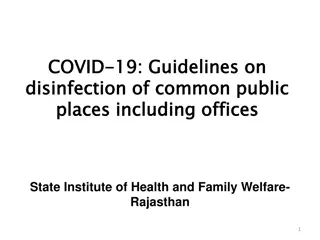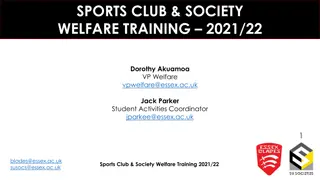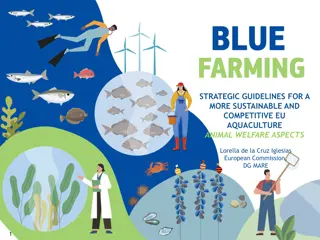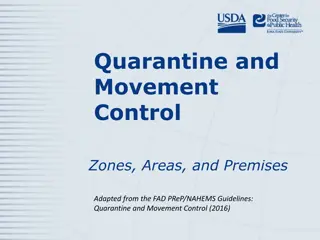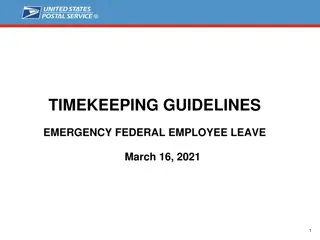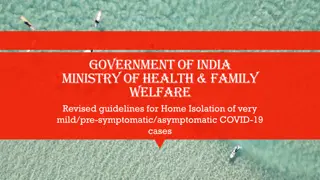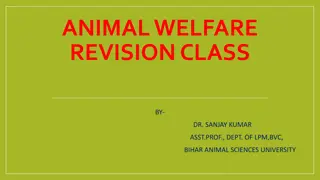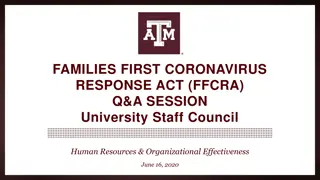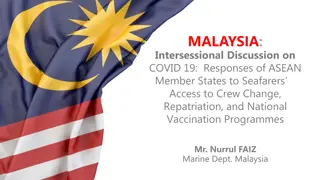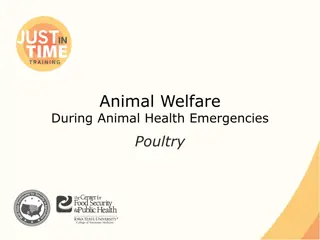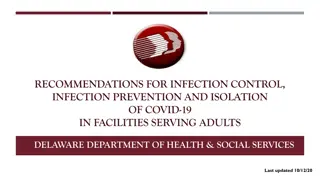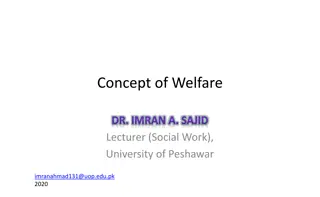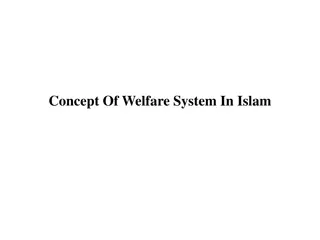Guidelines for COVID-19 Quarantine Facilities by State Institute of Health & Family Welfare
Quarantine is the separation and restriction of movement to prevent disease transmission. It can be applied at individual or group levels, with a recommended duration of up to 14 days for COVID-19. Quarantine facilities should be located away from populated areas, well secured, and easily accessible for supplies and medical care. Basic infrastructure and ventilation are essential considerations.
Download Presentation

Please find below an Image/Link to download the presentation.
The content on the website is provided AS IS for your information and personal use only. It may not be sold, licensed, or shared on other websites without obtaining consent from the author. Download presentation by click this link. If you encounter any issues during the download, it is possible that the publisher has removed the file from their server.
E N D
Presentation Transcript
Guidelines for Quarantine facilities for COVID Guidelines for Quarantine facilities for COVID - -19 19 State Institute of Health & Family Welfare Rajasthan 1
Quarantine Quarantine The separation and restriction of movement or activities of persons who are not ill but who are believed to have been exposed to believed to have been exposed to infection infection, for the purpose of preventing transmission of preventing transmission of diseases diseases. Persons are usually quarantined in their homes, but they may also be quarantined in community- based facilities. 2
Quarantine Quarantine contd contd Quarantine can be applied to individual or group exposed at a large public gathering or on a conveyance during international travel. A wider population- or geographic-level basis. Examples include the closing of local or community borders or setting up barrier around a geographic area with strict enforcement to prohibit movement into and out of the area. 3
Quarantine Duration: As per recommended for Covid-19 - upto 14 days from the time of exposure. Purpose: to reduce transmission by separating contacts of COVID-19 patients from community monitoring contacts for development of sign and symptoms of COVID-19, and segregation of COVID-19 suspects, as early as possible from among other quarantined persons Quarantine contd contd 4
Requirements for Quarantine facility Location preferably placed in the outskirt of the urban/ city area (can be a hostel/unused health facilities/buildings, etc.) away from the people s reach, crowded and populated area well protected and secured (preferably by security personnel/ army) preferably should have better approachability to a tertiary hospital facility having critical care and isolation facility Requirements for Quarantine facility 5
Requirementscontd. Requirements contd. Access considerations Parking space including Ambulances etc. Ease of access for delivery of food/ medical/ other supplies Differently-abled Friendly facilities (preferably) Ventilation capacity Well ventilated preferably natural 6
Requirementscontd. Requirements contd. Basic infrastructure/functional requirements Rooms/Dormitory separated from one another may be preferable with in-house capacity of 5-10 beds/room Each bed to be separated 1-2 meters (minimum 1 metre) apart from all sides. Lighting, well-ventilation, heating, electricity, ceiling fan Potable water to be available Functional telephone system for providing communications. Support services- fooding, snacks, recreation areas including television Laundry services Sanitation services/Cleaning and House keeping Properly covered bins as per BMW may be placed 7
Requirementscontd. Space requirements for the facility: Administrative offices- Main control room/clerical room Logistics areas/Pharmaceutical rooms Rest rooms- doctors/nurses/supporting staffs Clinical examination room/ nursing station / Sampling area Laundry facilities (on- or off-site) Mess/Meal preparation (on- or off-site) Holding area for contaminated waste Wash room/Bathroom/Toilet Requirements contd. 8
Requirementscontd. Social support resources/ Recreational areas Television and radio / Reading materials/ indoor plays Monitoring the health of contacts monitored at least daily for fever and respiratory symptoms. Standard operating Procedures ensure smooth operation in the quarantine facility, Daily monitoring surveillance using the daily reporting format Fever triage/ Isolation Case and contact monitoring and response Transfers of suspect/symptomatic to designated hospital (through ambulances) Public information Provider information (SOPs) Requirements contd. 9
Requirementscontd. Requirements contd. Functional flow should be maintained to reduce/ minimise the interactions between quarantine people and healthcare professionals/ supporting staffs so that transmission of disease is prevented and controlled 10
Risk assessment of the quarantine Risk assessment of the quarantine facility facility Risk level refers to how likely it is that someone in the Quarantine camp will become infected with corona virus as a result of movements and activities performed in the Quarantine camp. Risk assessment includes identification of the biohazard risk precaution levels, along with its associated activities. 11
Risk assessmentcontd. Risk assessment contd. Areas segregated and labeled as: Low risk areas: Areas having less direct contact with evacuee suspects such as control room center, nursing station and areas of kitchen where food is cooked. Moderate risk areas: where infectious aerosols are generated from areas where the suspects were inhabiting; bed linen, pillows and nearby clothes; low concentration of infectious particles. Contaminated surface near the quarantine zones. 12
Risk assessmentcontd. High risk areas (containment Quarantine camp): Areas of direct dealing with suspects medical examination room, sample collection areas (high concentration of infectious particles while coughing, sneezing, gag reflex during nasopharangeal & oropharangeal sample collection). Toilet and bathroom areas, dining areas, areas of bio-waste collections, segregation and disposal. Based on risk assessment, areas should be earmarked and infection prevention control measures to be applied as per MOHFW guidelines. Risk assessment contd. 13
Securing Entry and Exit points To prevent and control infection in the facility, strategic points in the facility needs to be identified including The Control room where a person entering inside quarantined building to get proper awareness and training on infection control measures A well informed and trained security to check (main entrance gate of the area) and a guard (24*7) with registers for ins and outs and a designated nursing officer for checking proper PPE wear (main entrance gate in the building) Securing Entry and Exit points 14
Securing Entry and Exit points Securing Entry and Exit points The international biohazard warning symbol and sign to be displayed on the doors of the rooms where suspects are kept, BMW management areas, samples of higher risk groups are handled Only authorized & trained persons or those designated in work areas permitted to enter the quarantine areas; Doors to keep closed at all times preferably under observation of a guard. There should be double door entry and managed with only one door to be open at a single time. 15
Human resource Deployment Chief Medical officer needs to be appointed as In-charge /nodal officer for overall coordination and supervision of the quarantine center. Services of General duty medical doctors, Medicine specialists, Pediatrics, Microbiologist (for diagnostic support and IPC), Psychiatrists & Psychologists for routine examination and relevant clinical care of the quarantined people. Para-medics including Staff Nurse and Lab. Technician, Pharmacist need to be posted. Public Health Specialist are required for monitoring public health aspects of the facility while Services of clinical microbiologist for sample collection, packaging and infection prevention & control practices. House keeping staff also need to be deployed. Human resource Deployment 16
HR duty HR duty For facility of 300 persons On- Duty Doctors in 6 hours shift of 2 doctors Nursing Staff in 6 hours shift of 4 nurses Technicians in 6 hrs shift of 4 technicians 17
Training Training Most important and critical part to ensure that all activities takes place as per established protocol and SOPs. Training Medical officers on SOPs for daily examination, movements in the facility, infection prevention control measures and use of PPE kit etc. Clinicians, laboratory technicians and medics on appropriate sample collection (nasopharyngeal and throat) and triple layer packaging with cold chain maintenance. Paramedical staffs i.e., staff nurses; medics, pharmacist etc. on SOPs to be followed at Quarantine centers and use of PPE kit. Staff undertaking the work in Laundry, Mess/Canteen, security and other related staff i.e., drivers, general duty staff etc. on use of mask, gloves, cleaning and disinfection procedures and use of PPE kit, etc. 18
Training Training Refresher training or regular direction to all the above staffs on need basis. When new staff is posted, it needs to be ensured that he/she receive proper training before undertaking the work. All activities / procedures must be done under strict monitoring/observations of trained specialists. 19
Daily Clinical Examination and referral All quarantined people needs to be examined twice (morning & evening) daily clinically and Those requiring referrals for related symptoms of Corona virus (fever, breathlessness etc.) or any other reason needs to be referred to designated hospital in ambulance directly with due precautions as per referral SOP. Ambulances need to be placed in the facility in standby mode for transport including advanced lifesaving ambulance. Daily census of the people needs to be undertaken twice a day (ex. Morning 8 am and evening 6 pm). Daily Clinical Examination and referral cough, sore throat, 20
Coordination Coordination Chief Medical Officer needs to supervise and coordinate with various organizations working with the facility. To ensure all activities take place according to standard protocol, separate teams to be constituted for various purposes such as Supervisory team, admin team, logistic team, referral team, medicine / equipment team, hygiene sanitation team. Daily review meetings needs to be conducted under chairmanship of Chief medical officer to discuss day to day affairs and sort out any issue requiring attention. 24x7 control room needs to be established at the facility with monitor for CCTV cameras and speakers at each floor so that quarantined people can be communicated on routine basis and necessary instructions can be provided. 21
Recording and reporting mechanisms To ensure standardized reporting, daily reporting formats of suspected cases with symptoms related to corona virus, no. of cases requiring referral, sample collection status needs to designed. It needs to be sent daily to relevant higher authorities. Recording and reporting mechanisms 22
Monitoring and Supervision Monitoring and Supervision Daily monitoring visit needs to be conducted inside quarantine facility and outside the facility in the surrounding campus by public health and in-charge officers and gaps to be noted. Necessary corrective actions and preventive actions to be taken by the nodal officer. Visits by senior officers from for regular review. 23
Establishment of Infection Prevention Control (IPC) measures As per risk assessment undertaken for probability of infection from possibly infected quarantine people to health care, other staffs and surrounding areas. Special map of the facility needs to be prepared to outline the details of movement of health care and other personnel around the quarantine area and in the building. Ensure movement of health care staffs and other personnel as per the designed map to prevent and control infections. Separate fence needs to be raised around the building to prevent entry of animals especially dogs, monkeys and even birds if possible. Establishment of Infection Prevention Control (IPC) measures 24
Establishment of Infection Prevention Control (IPC) measures Well informed and trained security personnel needs to be deployed all around the building on 24x7 rotation basis to monitor the facility and to avoid entry of un- desired persons/animals and even birds for eating any food remains/droppings inside the area. Ensure all health care personnel use PPE as per guidelines, hence properly trained and assisted during wearing of PPE. Separate areas to be earmarked for PPE Donning and Doffing. Compliance for same to be ensured by nodal officer. Separate well informed and trained nursing officers need to be stationed at the building to regulate the movement of the staffs entering the facility. assigned the duty that every person entering the facility enters in the register of all the details on time of name, designation entry/exit. ensure that all the persons are labeled while entering the building so that they can be identified by security staff. At the entrance, two door entries may be ensured to avoid mixing of quarantine people with health care staff. Establishment of Infection Prevention Control (IPC) measures 25
Establishment of Infection Prevention Control (IPC) measures Ensure that all the quarantine facility is decontaminated daily (with disinfectants (freshly prepared 1% hypochlorite, detergent solution) including - surface mopping of all the floor, bathrooms, toilets facility, under side of beds, other related items placed in the rooms of quarantine people . A separate cubicle for people developing mild symptoms for temporary observation (transit room) so that it will lead to an early isolation of any symptomatic person and to prevent transmission to other cluster of groups. Establishment of Infection Prevention Control (IPC) measures 26
Lodging, Catering, Laundry and other related activities Disposable and pre-packed food to be served to quarantined people. Separate beds for all quarantined people, with distance of 1-2 meters with no bed facing opposite to each other. All beds with disposable bed sheet that should be changed on daily basis. Personal toiletries/ towel/ blanket/ pillow with covers/electric kettle, room heater and water dispenser may be provided to each person depending on availability. Lodging, Catering, Laundry and other related activities 27
Lodging, Catering, Laundry and other related activities A separate room needs to be assigned to perform laundry services for cleaning of all the clothes and other washing related activities. Before laundering, all the washable items to be placed in 1% hypochlorite up to 30 minutes and later washed in detergent solution. Lodging, Catering, Laundry and other related activities 28
Biomedical waste (BMW) Biomedical waste (BMW) management management To ensure that biomedical waste management in the facility takes place as per standard guidelines, separate yellow, red /black bags, foot operating dustbins needs to be kept at each floor and outside the facility. Doffing takes place in the designated area with all the PPE kit including mask, gloves is properly placed in yellow bags. health care workers collecting the possible infectious material such as food items, PPE kits from yellow bags should also wear PPE and following the IPC measures. Designated place to be earmarked outside the building for collection of yellow and black bags. collected at least twice daily by biomedical waste management vehicle/any other local established practice. 29
Biomedical waste (BMW) management Site of collection of biomedical waste should be regularly disinfected with freshly prepared 1% hypochlorite solution. All officials concerned with the administration and all other health care workers including medical, paramedical, nursing officers, other paramedical staff and waste handlers such as safai karmacharis, attendants & sanitation attendants needs to be well oriented to requirements of handling and management of general and biomedical waste generated at the facility. Steps in the management of biomedical waste include generation, accumulation, handling, storage, treatment, transport and disposal as mentioned in the SOP needs to be followed. Continuous training, monitoring & supervision to monitor the implementation to be done on daily basis to manage compliance related issues. All the generated waste from Quarantine facility to be treated as isolation waste and its disinfection /treatment was strictly monitored by specialists in the health authorities. Biomedical waste (BMW) management 30
Logistic management All logistic for use in quarantine facility to be purchased in advance as PPE, medical equipments -Thermal thermometer, Stethoscope, BP machine etc., office logistic, sample collection and packaging material, etc. Performa needs to be prepared and monitored by logistic team on daily basis for daily consumption of PPE, triple layer mask, gloves, etc. Logistic management 31
Information, Education & Communication (IEC) and Psycho An obvious sense of psychological fear and panic among all the quarantine people and some of the involved stakeholders like health care professionals/staffs including doctors, security personnel etc. An interpersonal communication needs to made to all of them Initially one after another in groups by Psychiatrist team Later on with individual counseling sessions Quarantine people needs to be explained on Universal infection control measures , personal protective measures, written instructions on Do s and Don ts in the quarantine zone to be provided to contain and avoid spread of the infection. Information, Education & Communication (IEC) and Psycho- -social support social support 32
Importance of frequent Hand washing to be instructed for strict compliance specially after touching surfaces like door handles, stair railings, bed railings, etc.. Everyday quarantine people to be counseled by clinicians regarding day to day queries. If needed, referral to be made to psychiatrist /psychologist team. If there is fear in the surrounding community it needs to be addressed. 33
Sample collection and packaging For baseline testing Samples (Nasopharyngeal swab and throat swabs) for COVID-19 need to be collected from all quarantine people and sent with triple layer packaging maintained in cold chain (2-8oC) to designated laboratory . Safe collection and handling of specimens in the Quarantine camp needs to be performed in identified locations as per the SOP. Sample collection and packaging 34
Specimen containers generally used are viral transport medim (VTM vials containing 3 ml medium) with falcon tubes (50 ml) as secondary layer of Triple layer packaging system. Containers needs to be correctly labeled to facilitate proper identification. Specimen request or specification forms to be placed in separate waterproof zip pouch envelopes with locking facility and pasted on the outside walls of the sample transport containers. Just before the end of the 14 days quarantine period, re-sampling of nasopharyngeal swabs needs to be done. 35
Discharge of quarantine people from Quarantine Facility The quarantine people needs to be discharged at the end of 14 days of incubation period provided samples are negative on re-sampling. Instructions should be provided to self-monitor their health at their home (home quarantine) for next 14 days and immediately report to their District Surveillance officer (DSO), in case of development of symptoms suggestive of COVID- 19. Written instructions were handed over to them individually. The District Surveillance Units (DSO) and State Surveillance Units (SSO) to be provided with contact details of the quarantine people to conduct active surveillance for next 14 days under intimation to the Central Surveillance Unit, IDSP (NCDC). Discharge of quarantine people from Quarantine Facility 36
Terminal Disinfection and decontamination procedures Quarantine facility terminal disinfection procedures to be performed as per guidelines. Cleaning/ decontamination to be performed using the proper personal protective equipment (PPE) and adopting three bucket system as prescribed in the SOP Spraying of 1% sodium hypochlorite working solution (dilution 1:4 from an initial concentration of 4%) to be done on all the surfaces (protecting electrical points/appliances). Followed by cleaning with a neutral detergent that is used for removing the traces formed by hypochlorite solution. Terminal Disinfection and decontamination procedures 37
Terminal Disinfection and decontamination procedures While cleaning, windows need to be opened in order to protect the health of cleaning personnel. All frequently touched areas, such as all accessible surfaces of walls and windows, the toilet bowl and bathroom surfaces needs to be carefully cleaned. All textiles (e.g. pillow linens, curtains, etc.) should be first treated with 1% hypochlorite spray and then, packed and sent to get washed in laundry using a hot-water cycle (90 C) and adding laundry detergent. 1% hypochlorite solution should also sprayed in the PPE doffing area and discard area twice a day on daily basis. Mattresses / pillows after spraying with 1% hypochlorite should be allowed to get dry (both sides) in bright sunlight for upto 3 hrs each. Terminal Disinfection and decontamination procedures 38
Requirements of Equipment for Quarantine Facility Equipment Requirements of Equipment for Quarantine Facility Daily Consumption for holding 300 persons 1 Gloves reusable vinyl or rubber gloves for environmental cleaning latex single-use gloves for clinical care Hair covers (optional) 200 1500 2 Particulate respirators (N95, FFP2, or equivalent) Medical (surgical or procedure) masks 150 3 1500 4 5 Gowns and aprons (single-use long- sleeved fluid-resistant or reusable non- fluid-resistant gowns ) PPE Kit 150 130 6 Alcohol-based hand rub 50 7 8 Plain soap (liquid if possible, for washing hands in clean water) 500 39
Requirements of Equipment for Quarantine Facility Requirements of Equipment for Quarantine Facility Equipment Equipment Daily Consumption Daily Consumption for holding 300 persons persons for holding 300 9 Clean single-use towels (e.g. paper towels) 1500 10 Sharps containers 5 11 Appropriate detergent for environmental cleaning and disinfectant for disinfection of surfaces, instruments or equipment 20 liters 12 Large plastic bags 200 100 13 Appropriate clinical waste bags 500 14 Linen bags 200 15 Collection container for used equipment 40
Source of the above information Source of the above information https://ncdc.gov.in/WriteReadData/l892 s/90542653311584546120.pdf 41
Thank You 42


